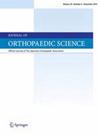腰椎椎体间融合术后剩余牙齿数量与假关节之间的关系:一项回顾性队列研究
IF 1.4
4区 医学
Q3 ORTHOPEDICS
引用次数: 0
摘要
假关节是后路腰椎椎间融合术(PLIF)和椎间孔椎间融合术(tliff)的主要并发症,其危险因素需要明确。本研究旨在探讨残牙数(NRT)与假关节的关系。方法回顾性分析63例(男性24例,女性39例,平均年龄71.2岁,平均随访49.1个月)行单级PLIF/TLIF (L3/4, L4/5, L5/S1)患者的snrt、术前股骨近端骨密度(青年平均百分比;% YAM)和术前1型n端前肽(P1NP) (μg/L)。术后24个月通过计算机断层扫描(CT)分析融合情况。结果NRT≤10组骨关节畸形发生率明显高于NRT≥11组(p < 0.05)。与融合组相比,假关节组的男性数量明显增加,YAM百分比明显降低。采用以下变量组合模型进行Logistic回归分析:模型1:年龄,% YAM, NRT;模型2:P1NP, % YAM, NRT;模型3:性别,% YAM, NRT。在所有模型中,NRT≤10与假关节相关(模型1:95%可信区间(CI): 1.81-25.14,优势比(ORs): 6.74, p < 0.01,模型2;95% CI: 1.57 ~ 30.54, or: 5.88, p = 0.01,模型3;95% CI: 1.95 ~ 39.02, or: 7.07, p < 0.01)。在模型3中,性别与假关节相关(95% CI: 1.23-16.92, or: 4.30, p = 0.02)。结论小NRT是腰椎椎体间融合术后假关节的危险因素。本文章由计算机程序翻译,如有差异,请以英文原文为准。
Association between the number of remaining teeth and pseudarthrosis after lumbar interbody fusion: A retrospective cohort study
Background
Pseudarthrosis is a major complication after posterior lumbar interbody fusion (PLIF) and transforaminal interbody fusion (TLIF), and its risk factors need to be identified. This study aimed to investigate the relationship between the number of remaining teeth (NRT) and pseudarthrosis.
Methods
NRT, preoperative bone density of the proximal femur (percentages of young adult mean; % YAM), and preoperative procollagen type 1 N-terminal propeptide (P1NP) (μg/L) were retrospectively investigated in 63 patients (24 male and 39 female, mean age: 71.2 years, mean follow-up: 49.1 months) who underwent single-level PLIF/TLIF (L3/4, L4/5, L5/S1). Fusion status was analyzed on computed tomography (CT) scan at 24 months after surgery.
Results
Pseudarthrosis was significantly more frequent in the NRT ≤10 group than in the NRT ≥11 group (p < 0.05). Compared with the fusion group, the pseudarthrosis group had significantly higher population of males and lower % YAM. Logistic regression analysis was performed with the following variable combination models; Model 1: age, % YAM, NRT; Model 2: P1NP, % YAM, NRT; Model 3: sex, % YAM, NRT. NRT ≤10 was associated with pseudoarthrosis in all models (model 1: 95 % confidence interval (CI): 1.81–25.14, odds ratios (ORs): 6.74, p < 0.01, model 2; 95 % CI: 1.57–30.54, ORs: 5.88, p = 0.01, model 3; 95 % CI: 1.95–39.02, ORs: 7.07, p < 0.01). Sex was associated with pseudarthrosis in model 3 (95 % CI: 1.23–16.92, ORs: 4.30, p = 0.02).
Conclusions
Small NRT was found to be a risk factor of pseudarthrosis after lumbar interbody fusion.
求助全文
通过发布文献求助,成功后即可免费获取论文全文。
去求助
来源期刊

Journal of Orthopaedic Science
医学-整形外科
CiteScore
3.00
自引率
0.00%
发文量
290
审稿时长
90 days
期刊介绍:
The Journal of Orthopaedic Science is the official peer-reviewed journal of the Japanese Orthopaedic Association. The journal publishes the latest researches and topical debates in all fields of clinical and experimental orthopaedics, including musculoskeletal medicine, sports medicine, locomotive syndrome, trauma, paediatrics, oncology and biomaterials, as well as basic researches.
 求助内容:
求助内容: 应助结果提醒方式:
应助结果提醒方式:


